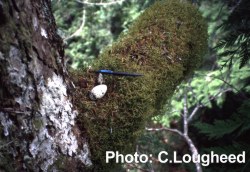This is the third in a series of weekly posts on birds at risk in Canada. The Committee on the Status of Endangered Wildlife in Canada (COSEWIC) lists 73 bird species as endangered, threatened or of special concern.

Marbled Murrelets are the only members of the Auk Family to nest in trees.
Virtually unknown until the past few decades, these small birds have the sad distinction of being the only ocean dwelling species threatened by logging.
The COSEWIC Status Report states:
Reason for Designation: This species has a fairly large population in Canada but there are immediate threats to breeding habitats from logging, and to populations from gill netting and oil spills. If these threats are not reversed, a significant decline in populations is highly probable.
Status History: Designated Threatened in April 1990. Status re-examined and confirmed in November 2000. Last assessment based on an update status report.
Marbled Murrelets are small, plump shorebirds with short, pointed bills and tails. They measure just 24-25 cm (9-10”) in length, and weigh less than a pound.
Non-breeding adults are blackish with white underparts. Before breeding season, they moult their black and white feathers and become a dull brown, aiding their camouflage while incubating.
Their chunky bodies are propelled underwater with rapid, vigorous motions of their wings. While flight is awkward, they use their wings for propulsion underwater, and are excellent swimmers and divers. Their feet are used for steering, and are placed so far back on the body walking is impossible and they move on land by hopping. To assume an upright posture while standing, they rest their body on their rumps, with their feet extended out in front.

Marbled murrelet nesting site
These birds range along the Pacific Coast of Canada, Alaska, Russia and Japan. They breed in coniferous forests near the coast, nesting on large horizontal branches high up in trees, usually in trees more than 200 years old. Winters are spent at sea.
In 1994, a Marbled Murrelet Recovery Team was formed in British Columbia. Estimating the number of these birds was difficult because, unlike most other seabirds, Marbled Murrelets do not nest in large colonies. They nest solitarily over much of the coast, and never congregate in large numbers.
Researchers used radar to detect the Murrelets flying in and out of coastal inlets, and conducted sea surveys, running transects and counting the birds on coastal waters where they feed.
Their research also concentrated on nesting sites. Their website states:
Marbled Murrelet nests are very difficult to find. The first nest was not found in B.C. until 1990. Most nests have been found on large, moss-covered branches (15-75 cm diameter) of large, old-growth conifer trees. A couple of nests have been found on cliff ledges and one has been found in a deciduous tree. Marbled Murrelets are poor fliers who do not build nests. They fly into an opening in a forest canopy and stall-land on a wide, mossy bough with overhead foliage that provides cover. The bough must be high enough for them to jump off and start flying from a free-fall.
Very little is known about the population size or biology of these secretive little birds. Since the publication of the Marbled Murrelet Recovery Plan in British Columbia, considerable effort has been directed towards research on these amazing little sea dwellers.



Pingback: Twitter Trackbacks for Feathered Feathers: Marbled Murrelet [birdcanada.com] on Topsy.com